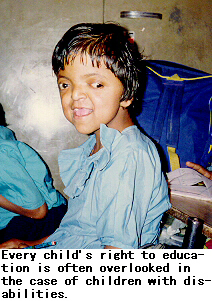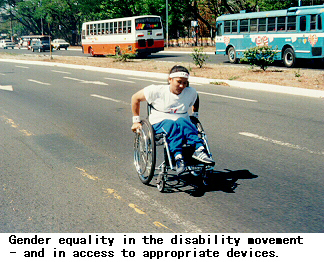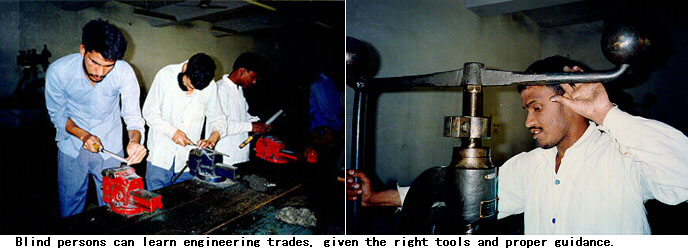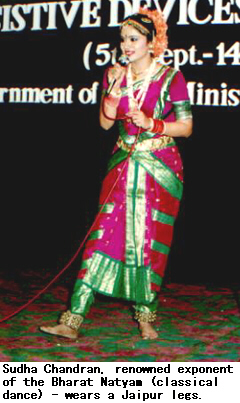GLOSSARY
alignment: The degree to which the parts of a prosthesis or orthosis fit into the correct position with the user's body and with one another.
assistive device: An item that can directly enable people with disabilities to participate in activities of daily life.
brace: See orthosis.
caliper: See orthosis.
disability: Any restriction or lack (resulting from an impairment) of ability to perform an activity in the manner or within the range considered normal for a human being.
endoskeletal prosthesis: A lower-limb prosthesis whose strength comes from a central tube, or pylon, on the inside of it. The shape and appearance of the prosthesis are provided by a covering, usually made of foam or polypropylene.
exoskeletal prosthesis: A prosthesis in which the shank is shaped like a leg and forms the outside of the prosthesis.
foot-drop: The condition that causes a foot to drop downward so that only the toes touch the ground when the foot is lifted. It results from the effect of gravity on a weak ankle.
gait: Pattern of walking.

handicap: The disadvantage for a given individual, resulting from an impairment or a disability, that limits or prevents the fulfilment of a role that is normal (depending on age, sex, and social and cultural factors) for that individual.
impairment: Any loss or abnormality of psychological, physiological or anatomical structure or function.
keel: A solid piece, located in the central part of a prosthetic foot, around which the whole foot is moulded.
locomotor disability: A disability that affects movement of body parts.
modular: Made of a number of smaller, units (modules) which can be assembled in a workshop to make a complete device. Each module is interchangeable with other modules having the same or similar function.
myoelectric hand: An artificial hand which uses electrodes to pick up muscle contractions in the stump, using these for movement.
orthosis: A device fitted to an existing limb to keep that limb in a functional position. Orthoses are also called braces or calipers. Small orthoses, especially for upper extremities, are also called splints.
prosthesis: A device which replaces a missing body part to restore its function and appearance, such as an artificial limb.
pylon: See endoskeletal prosthesis.
shank: The structural member that connects the foot-ankle assembly of a lower-limb prosthesis to the socket or the knee unit. The primary purpose of a shank is to transfer the load of body weight to the foot and the ground surface.
socket: The portion of an artificial limb which comes in contact with a stump. It is shaped to hold the stump.
splint: See orthosis.
stump: The remaining portion of an amputated limb, which comes into contact with an artificial limb.
LIST OF ABBREVIATIONS
| AFO | ankle foot orthosis |
| AK | above-knee |
| ALIMCO | Artificial Limb Manufacturing Company (India) |
| APHT | Association of the Physically Handicapped of Thailand |
| BK | below-knee |
| CBR | community-based rehabilitation |
| CP | cerebral palsy |
| CRP | Centre for the Rehabilitation of the Paralysed (Bangladesh) |
| CRRC | China Rehabilitation Research Centre |
| DST | Department of Science and Technology (India) |
| ESCAP | Economic and Social Commission for Asia and the Pacific |
| FESPIC | Far East and South Pacific Games for Disabled Persons |
| FRO | floor reaction orthosis |
| HI | Handicap International |
| HDPE | high-density polyethylene |
| HKAFO | hip knee ankle foot orthosis |
| HRD | Human resources development |
| HRDC | Hospital and Rehabilitation Centre for Disabled Children (Nepal) |
| ICRC | International Committee of the Red Cross |
| ISO | International Standards Organization |
| KAFO | knee ankle foot orthosis |
| KAMPI | Katipunan Ng Maykapansanan Sa Pilipinas Inc. (National Federation of Disabled Persons, Philippines) |
| MSALVA | Ministry of Social Affairs, Labor and Veterans Affairs (Cambodia) |
| NGO | non-governmental organization |
| NRC | National Rehabilitation Centre for the Physically Handicapped (Indonesia) |
| POP | plaster of Paris |
| PTB | patellar-tendon-bearing |
| PVC | polyvinyl chloride |
| R&D | research and development |
| SACH | solid ankle cushion heel |
| SCI | spinal-cord injury |
| TCDC | technical cooperation among developing countries |
| WHO | World Health Organization |
| WTO | World Trade Organization |

MEMBERS AND ASSOCIATE
MEMBERS OF ESCAP
Members (51)
| 1. Afghanistan 2. Armenia 3. Australia 4. Azerbaijan 5. Bangladesh 6. Bhutan 7. Brunei Darussalam 8. Cambodia 9. China 10. Democratic People's Republic of Korea 11. Fiji 12. France 13. India |
14. Indonesia 15. Islamic Republic of Iran 16. Japan 17. Kazakhstan 18. Kiribati 19. Kyrgyzstan 20. Lao People's Democratic Republic 21. Malaysia 22. Maldives 23. Marshall Islands 24. Micronesia (Federated States of) 25. Mongolia 26. Myanmar |
27. Nauru 28. Nepal 29. Netherlands 30. New Caledonia 31. Pakistan 32. Palau 33. Papua New Guinea 34. Philippines 35. Republic of Korea 36. Russian Federation 37. Samoa 38. Singapore 39. Solomon Islands |
40. Sri Lanka 41. Tajikistan 42. Thailand 43. Tonga 44. Turkey 45. Turkmenistan 46. Tuvalu 47. United Kingdom of Great Britain and Northern Ireland 48. United States of America 49. Uzbekistan 50. Vanuatu 51. Viet Nam |
Associate Members (9)
- 1. American Samoa
- 2. Cook Islands
- 3. French Polynesia
- 4. Guam
- 5. Hong Kong, China
- 6. Macau
- 7. New Caledonia
- 8. Niue
- 9. Northern Mariana Islands

SELECTED REFERENCES
Australian Council for Rehabilitation of Disabled and International Commission on Technical Aids, Building and Transportation (ICTA*1) Information Centre.
(*1 ICTA now stands for International Commission on Technology and Accessibility.)
Asia Pacific disability aids and appliances handbook.
Curtin, A.C.T., Australia, 1982.
Appropriate Health Resources and Technologies Action Group (AHRTAG).
Essential CBR information resources: an international listing of publications.
London, 1996.
Borg, Johan.
BREATH: Bangladesh's resources in assistive technology.
Dhaka, Bangladesh, InterLife, 1996.
European Commission.
Userfit: a practical guide handbook on user-centred design for assistive technology.
Brussels-Luxembourg, ECSC-EC-EAEC, 1996.
Handicap International Technical Publishing Department.
A plastic caliper for children: a technique of appliance and physical therapy for polio affected children.
Training Centre, Pondicherry, India, second quarter, 1994. ISBN: 2-909064-14-X.
Helander, Einer and others.
Training in the community for people with disabilities.
Geneva, World Health Organisation (WHO), 1989. Published also in French, Portuguese and Spanish.
Ho Nhu Hai, "Motor Disabled People in Rural Areas of Vietnam",
Round Table Meeting on the Integration of Disabled People in Agricultural and Agro-Industry Systems organised by the Food and Agriculture Organisation of the United Nations, 13-15 May, Bangkok, Thailand, 1997.
Hotchkiss, Ralf.
Independence through mobility: a guide to the manufacture of the ATI-
Hotchkiss wheelchair.
Washington, D.C., Appropriate Technology International, 1985.
Human Resources Department Canada.
Tips, tools and techniques: homes maintenance and hobbycraft, people with disabilities and seniors.
Ottawa, 1995.
ICTA Information Centre.
The disabled person as a consumer of technical aids.
Bromma, Sweden, December 1984.
ICTA Information Centre and African Medical and Research Foundation.
Local Production of Appropriate Technical Aids for Disabled People: Report from RI Post-Congress Workshop in Kibwezi, Kenya, 14-16 September, 1992.
Order no. 94528. ISBN 91-88336-23-9.
ICTA Information Centre and AHRTAG.
Appropriate Technical Aids for DisabledPeople: Ways and Means for Their Production in the Third World. Report from a seminar in Bombay, India, September 22-26, 1986.
ISBN no. 91-8631-027-5.
ICTA Information Centre, Rehabilitation International.
Report from the ICTA seminar on Appropriate Technology An Essential Part of a CBR programme, 12 September, 1995, Jakarta, Indonesia.
Vallingby, Sweden, Order no. 96530, ISBN 91-88336-74-3.
India.
- Ministry of Welfare. Rehabilitation Council of India. Indian Association for Special Education and Rehabilitation.
Report on manpower development.
New Delhi, January 1996. - Rehabilitation Technology Centre. DRC Scheme.
Aids and appliances: a report on availability and research and development activities.
New Delhi, February 1990. - Rehabilitation Technology Centre.
Research and development activities for development of assistive devices for people with disabilities.
New Delhi, 1995. - Research Division. National Society for Equal Opportunities for the Handicapped. National Information Centre on Disability and Rehabilitation.
Directory of Indian Assistive Devices: 1995.
New Delhi, 1995.
ISPO.
Report of the Consensus Conference on Appropriate Prosthetic Technology for Developing Countries, Phnom Penh, Cambodia, 5-10 June, 1995.
Lagerwall, Tomas.
Appropriate Aids and Equipment for Disabled People in Africa: Ways and Means for Local Production in the Third World : Report from a seminar in Harare, Zimbabwe, 20-26 March, 1988.
Bromma, Sweden, ICTA. ISBN: 91-86310-53-4.
Mathu, M.K.
The Jaipur above-knee prosthetic systems: fabrication manual.
Jaipur, India, SMS Medical Centre, 1989.
Minto, Hasan, and Awan, Haroon.
Management of low vision for developing countries.
Rawalpindi, Pakistan, Al-Shifa Eye Hospital and Pakistan Institute of Ophthalmology, 1995.
Olney, S. and others.
Rehabilitation technology in community based rehabilitation: a compendium.
Kingston, Ontario, Canada, International Centre for the Advancement of Community Based Rehabilitation (ICACBR), September 1995.
Philippines.
- National Council for the Welfare of Disabled Persons.
Guidebook on assisting disabled and elderly people who travel.
Quezon City, Philippines, 1995. - Technical Cooperation Centre (TCC).
Catalogue of assistive devices for persons with orthopaedic disabilities in the Philippines.
Quezon City, Philippines, 1996.
Saha, R. Role of technology in rehabilitation of handicapped.
Standards India.
(New Delhi) v. 6, January 1993.
Saha R. and others.
- Study of wheelchair operations in rural areas covered under the District Rehabilitation Centre (DRC) scheme.
Indian journal of disability and rehabilitation
(New Delhi), July-December 1990. - Technology and employment opportunities for disabled in industry.
Indian journal of disability and rehabilitation
(New Delhi), January-June 1992. - Uncleared landmines: the scope of the problem in Africa, Asia, the Middle East, the Americas and Europe.
UNIDIR Newsletter
No. 28/29:47, December 1994/May 1995.
Spastics Society of India.
UPKRAN: a manual of aids for the multiply handicapped.
Bombay, India.
United Nations.
- Economic and Social Commission for Asia and the Pacific.
Promotion of non-handicapping physical environments for disabled persons: guidelines.
(ST/ESCAP/1492). - European Commission for Europe, in cooperation with International Federation for Medical and Biological Engineering.
Rehabilitation Engineering: review publication prepared for the World Summit for Social Development.
Geneva and New York, 1995. United Nations publication, Sales No. E 94.II.E.17. ISBN 92-1-116595-4. (ECE/ENG.Aut/55) - United Nations Childrens' Fund.
Relief and rehabilitation of traumatized children in war situations.
Paper submitted for the World Summit on Children, 1990. - United Nations Development Programme.
Prejudice and dignity: an introduction to community-based rehabilitation
by Einer Helander. 1993. United Nations publication, Sales No. E93-III-B.3.

Werner, David.
- Disabled village children: a guide for community health workers, rehabilitation workers and families.
Palo Alto, California, Hesperian Foundation, 1988. - Helping health workers learn.
Palo Alto, California, HealthWrights, 1982. - Nothing about us without us: developing innovative technologies for, by and with disabled persons.
Palo Alto, California, HealthWrights, 1998. - and Sanders, David.
Questioning the solution: the politics of primary health care and child survival.
Palo Alto, California, HealthWrights, 1997.
WHO.
- Guidelines for training personnel in developing countries for prosthetic and orthotic services.
(Based on the outcome of a WHO consultation on the training of personnel for prosthetic and orthotic services in developing countries, WHO Eastern Mediterranean Regional Office, Alexandria, Egypt, June 1990. - Guidelines for the prevention of deformities in polio.
Geneva, 1995. - Promoting the development of young children with cerebral palsy: a guide for mid-level rehabilitation.
Geneva, 1993.
Go back to the Contents
ECONOMIC AND SOCIAL COMMISSION FOR ASIA AND THE PACIFIC
Production and distribution of assistive devices for people with disabilities: Part 1
- ANNEX -
Printed in Thailand
November 1997 1,000
United Nations Publication
Sales No. E.98.II.F.7
Copyright c United Nations 1997
ISBN: 92-1-119775-9
ST/ESCAP/1774
